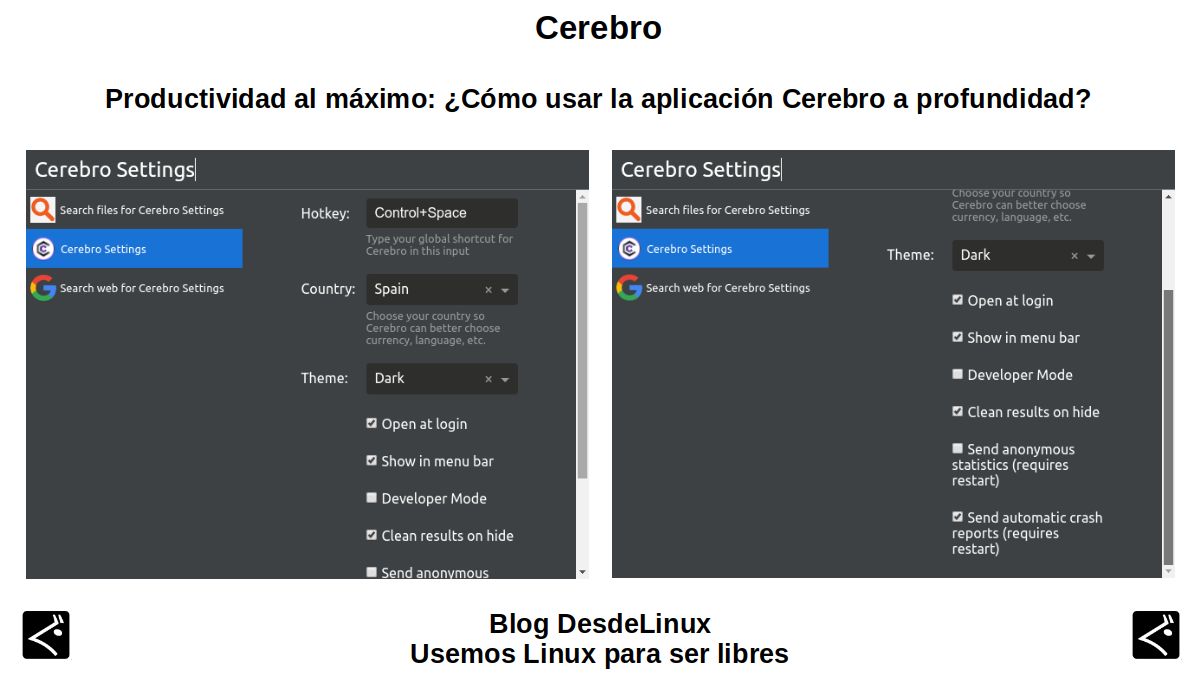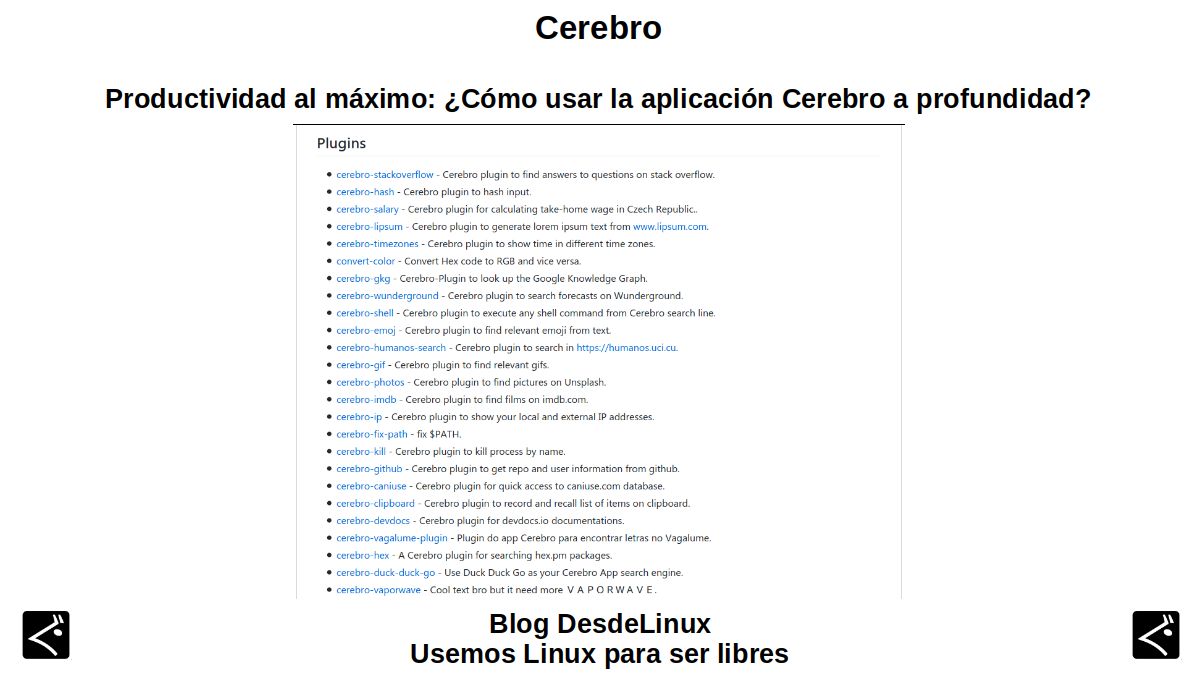
Productivity to the maximum: How to use the Brain application in depth?
After our previous post about the latest stable version and the possible ways to install the interesting and useful open source and cross-platform application call BrainWhich enables improve user productivity on the desktop of their computers, we will continue with this tutorial on how to use it.
All in order to better explain its use and management of some of the best or most practical plugins that you have available to achieve the goal of increasing our productivity on our computer, especially when they have installed a Free and open operating systemas GNU / Linux.

It is good to note that Brain app, it is not an extremely heavy application, that is, it consumes too many CPU, RAM or HDD resourcesHowever, for those users who always want to have the resource consumption on their computers to a minimum, it is good to clarify that Brain can make them consume a certain precious amount of them, especially when it is used, since at rest, definitely its resource consumptions are very acceptable.

Thus, it is not recommended to use it if it is definitely a low-resource computer or you want to make the most of each% of our computer resources in other areas or tasks.

Productivity on GNU / Linux: Learning to use Cerebro
Brain initial setup
The initial and essential configuration of Cerebro it is very basic. his configuration window boils down to the following parameters:
- Direct Access Key (HotKey): In this section the application allows you to configure the combination of keys necessary to activate the application without the need for mouse (mouse). By default, the key combination is configured
«Ctrl+Space». But it allows it to be changed if we position ourselves on the text box and press the key«Ctrl»and without releasing it, we press a second key to replace (replace) the key«Space». - Country (Country): In this section we can indicate to Cerebro our current country, so that later, it can use that information to personalize or optimize data to provide us. For example, with a plugin (plugins) de weather weather) give us more specific and direct data.
- Theme: In this section we are allowed to select a specific Theme to change the visual aspect of the application's graphical interface. And of course, bring a theme
«Dark», which is usually highly appreciated by many.
Other
- Various options: At the end of the configuration window, we are shown a series of options called:
- Open at login: To tell the application to load when the operating system starts and the user logs into it. This option is enabled by default.
- Show in menu bar: To tell the application to show an icon of the same, in the task bar above the notification area of the Desktop Environment used. This option is enabled by default.
- Developer Mode: This is an advanced option used by those dedicated to debugging the application, therefore, this option is not activated by default, and it is not recommended to activate it unless you are an advanced user.
- Clean results on hide: This option tells the application to delete our searches and background operations every time it is restarted. This option is enabled by default.
- Send anonymous statistics - requires restart: This option is available to allow the sending of information on the use of the application to its developers to use it, to improve it. This option is not activated by default.
- Send automatic crash reports - requires restart: This option is available to allow the sending of information about errors of the application to its developers to use it, to improve it. This option is enabled by default.
Ways of scrolling
In addition, the use of the mouse (mouse) to move in the application, it allows the use of the keyboard to move within it. The keys arranged for this are the following:
- Side direction arrows
« <- -> »y« ctrl + j/k »are used to select the next or previous item. - Keys
« enter »and the letter« o »are used to select an item. - Keys
« escape »or left arrow« <- »they are used to move the selection back to the main results list.
Keyboard shortcuts (HotKeys)
C key
- Brain Setting (See Configuration)
- Brain version (See version number)
E key
- Empty Trash (Empty the trash)
- Brain Exit (Close the application)
M key
- mute off (Turn off computer volume)
O key
- Wi-Fi On (Turn on the WiFi device of the computer)
- Wi-Fi Off (Turn off the WiFi device of the computer)
P key
- Manage plugins (Manage Brain plugins)
- Brain Setting (See Configuration)
Q key
- Brain Quit (Exit the application by closing it)
R key
- Reload (Reload the application)
S key
- Sleep (Enable computer hibernate function)
- Shut Down (Enable computer shutdown function)
- Brain Setting (See Configuration)
T key
- Empty Trash (Empty the trash)
U key
- Unmute (Turn on computer volume)
V key
- Brain version (See version number)
Keys 1 to 9 and Key »*«
- Brightness (Screen brightness level)
Keys »+» and »-«
- Volume (Computer volume level)
"Arrow up" key
- Last command executed (Last command executed)
Plugins
For now, Brain has the following available plugins, of which we will talk later and in detail to facilitate their use and implementation, in favor of the productivity of all its users, regardless of the Operating System used.
Comments
Personally, I think it would be better than Brain should improve on the following for better use:
- Allow resizing of the configuration window.
- Let the floating search bar dock to the Desktop.
- Seek its translation into several languages, especially Spanish.
- Become more compatible with more modern versions of GNU / Linux Distributions.
- Get updated more regularly, not just focus on the great add-ons added.

Conclusion
We hope this "useful little post" about «Cerebro», the second of my authorship and the third in the Blog, facilitate the use and adaptation of said application in those users eager to maximize their productivity on their computers, and consequently, it is very interest and utility, For the whole «Comunidad de Software Libre y Código Abierto» and of great contribution to the diffusion of the wonderful, gigantic and growing ecosystem of applications of «GNU/Linux».
And for more information, always do not hesitate to visit any Online library as OpenLibra y jedit to read books (PDFs) on this topic or others knowledge areas. For now, if you liked this «publicación», don't stop sharing it with others, in your Favorite websites, channels, groups, or communities of social networks, preferably free and open as Mastodon, or secure and private like Telegram.
Or simply visit our home page at DesdeLinux or join the official Channel Telegram from DesdeLinux to read and vote for this or other interesting publications on «Software Libre», «Código Abierto», «GNU/Linux» and other topics related to «Informática y la Computación», and the «Actualidad tecnológica».
Of the applications of this style I prefer 'Albert'.
Greetings HSequeda!
Thank you for your comment and suggestion. I'm already testing "Albert" and it looks really good. I will surely do an article about her soon.
For now, I will be doing the third and last article on Cerebro, specifically on the handling of some very useful add-ons (plugins) that it has to increase its productivity.
I used brain for a long time until it started to give me problems, and it is that its maintenance / development seems to be stagnant; It has not been updated since 2017. Version 3.1 worked for me but 3.2 never did. On the other hand, Alber seems to be better in that regard.
Greetings Moltke!
Thank you for your comment and suggestion. I'm already testing "Albert" and it looks really good. I will surely do an article about her soon.
For now, if you wish, you can read the third and last article on Cerebro, specifically on the management of some very useful add-ons (plugins) that it has to increase its productivity: https://blog.desdelinux.net/complementos-cerebro-plugins-aumentar-productividad/